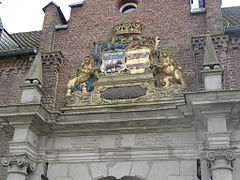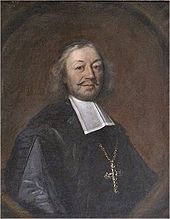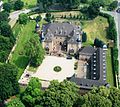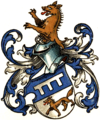Wolff-Metternich
Wolff-Metternich zur Gracht (formerly also called Wolff von Metternich ) is the name of a Rhenish and Westphalian noble family that descends from the North Hessian lords Wolff von Gudenberg .
The Wolff-Metternich family should not be confused with the counts and princes of Metternich-Winneburg , who have since died out , but adopted the double name in 1440 through the marriage of an heir to those of Metternich .
history
origin

“Before · Was · I · from · Hesse · Landt ·
Von · GudenBerg · A · Wolff · Genandt
Now · Am · I · Here · Through · God's · Power
Heisch · Wolff · Gnant · Metternich · Zur · Canal "
The Hessian family of Wolff von Gudenberg , often referred to in older literature as the "Wölffe von Gudenberg" or "Lupi" (Latin for 'wolves'), is first tangible in 1213 with Arnold I, who is therefore considered the founder of the family.
Wilhelm Wolff von Gudenberg zu Itter, probably a son of Arnold VI. and thus grandson of Thile I. Wolff von Gudenberg , went to Andernach in 1429 . His son Gotthard (Goddart) Wolff von Gudenberg zu Itter married Sybilla von Metternich in 1440 , the only daughter and heir to Carl II von Metternich. With his marriage he acquired shares in the rule Metternich near Euskirchen and now carried the name "Wolff called von Metternich". The Metternich Castle (Weilerswist) still belonged to the Metternichs ( until it was sold in 1692). Gotthard's great-grandson Hieronymus took on the surname “zur Gracht” in 1538 after his marriage to Katharina von Buschfeld, heir to Gracht .
Status surveys
The Imperial and Electoral Cologne Chamberlain and Court Marshal Johann Adolf Wolff, called von Metternich (1592–1669), was raised to the status of imperial baron in 1637 . In 1731, Franz-Joseph von Wolff-Metternich zur Gracht, Imperial Chamberlain and Reichshofrat, a line of the family was elevated to the status of Imperial Count.
Distribution and Possession
By marrying Sybille von Metternich in 1440, a branch of the Hessian Wolff family first came to the Rhineland and acquired many possessions and high offices there and later in Westphalia.
- Rhineland
In 1538, through marriage to a von Buschfeld, the Gracht Castle in Erftstadt- Liblar came into the family and became the starting point for spreading in the Rhineland and then in East Westphalia. This also included the Grachter Hof in Liblar, which was expanded through acquisitions in Spurk. In the 16th century they also owned the Redinghoven moated castle .

By Johann Adolf Wolff Metternich to the canal (1592-1669), the family took another big boost. In addition to the lordship of Gracht-Liblar, he owned Haus Raedt and Haus Forst near Manheim as well as other farms and houses in Cologne. Through his marriage to a von Hall , Strauweiler Castle in the Bergisches Land came into the family (and remained so until another female inheritance in 1955), as well as the associated tower courtyard in Cologne-Zündorf .
During the Thirty Years' War Johann Adolf developed a lively diplomatic activity in the service of Kurköln and from 1646 Kurköln; In 1637 he was promoted to imperial baron. In 1630 he received high jurisdiction over Liblar from Kurköln as a pledge, with customs rights, income, services and other accessories, combined with the requirement not to tolerate Protestants in Liblar, in 1633 subordination over Liblar. In the course of the decades he received a number of other fiefdoms and subordinates from Kurköln: 1634 the Bergische Unterherrschaft Odenthal , 1635 the Electoral Cologne fiefdom Schloss Langenau an der Lahn, 1665 the Electoral Cologne fiefdom Wehrden in East Westphalia, furthermore in 1637 the Palatinate Unterherrschaft Flehingen in the Baden Kraichgau as the Elector Palatine fiefdom of Elector Maximilian of Bavaria and in 1658 the Bavarian fiefdom of Oberarnbach . He also owned a winery in Nierstein , vineyards in Bornheim and an Electoral Palatinate fiefdom in the Wetterau , land in Oberschlich near Jüchen , the Oberscheider Höfe near Engelskirchen , a farm in Linn , the Zündorfer Rheinwerth from the Duke of Jülich-Berg and one from the Cologne Elector Share in the income of "a Vahrdienst" of the Cologne-Deutz Rhine ferry. He confirmed his status as Herr zu Liblar by expanding the ancestral seat in Gracht into a representative castle in 1658. Of his 16 children, 14 reached adulthood, of which six sons and four daughters entered the clergy; the son Hermann Werner ruled as Prince-Bishop of Paderborn from 1683 to 1704 and provided his nephew with lucrative positions at court there.
- Westphalia
With the acquisition of Wehrden (Weser) and Amelunxen by the Paderborn prince-bishop Hermann Werner in 1695 (from the von Amelunxen family ), the family first gained a foothold in East Westphalia. He built Wehrden Castle there . From 1694 to 1700 he had the Bisperode Castle built as a baroque three-wing moated castle , also by the builder Ambrosius von Oelde , whose fief he had acquired and which remained in the family's possession until 1875. Around 1695 he acquired the Löwendorf estate from the von Kanne family. In 1697 he set up a Fideikommiss for his family from his property complex . This was expanded in 1884 by Gut Bruchhausen and again in 1930 by Gut Maygadessen . Maygadessen and Bruchhausen are still owned by the barons Wolff-Metternich; Wehrden and Amelunxen today belong to the heirs of Wolff-Metternich, Alexander and Andrea von Köckritz .
Gracht Castle in Liblar, owned by the family from 1538–1957
Strauweiler Castle , owned by the family for 350 years
Bisperode Castle , built by Prince-Bishop Hermann Werner
- More owner advertisements
In Hesse, the family acquired Weilbach Castle by means of a pledge around 1671 , which has remained in their possession to this day.
Max Felix Graf Wolff Metternich zur Gracht inherited his great-aunt Johanna Freiin von Gymnich , the last of her family, in 1824 and thus acquired the Gymnich Castle and the Nörvenich Castle in the Rhineland . Around 1900 these possessions, also by female inheritance, passed out of the family again, as did the Satzvey Castle (1882–1944), which also belonged to the Gymnich inheritance.
Gymnich Castle (19th century)
Nörvenich Castle (1825 to 1904)
Satzvey Castle was owned by the family until 1944
In 1850, after the death of Freiherr Friedrich Florens Raban von der Wenge (only son of Clemens August von der Wenge ), the Westphalian inheritance of his family fell to the descendants of his eldest sister Maria Franziska (1775–1800), who with Maximilian Werner von Wolff -Mebenich (1770–1839) was married, including the ancestral home Wenge House in Dortmund and Beck Castle . These properties, like Gracht, were sold in the 1950s.
Beck Castle , owned by the family until 1958
The ancestral seat Schloss Gracht remained in the family's possession until 1957, while Kleinbüllesheim Castle, which became part of the canal in the 19th century, still belongs to them today. The Baden moated castle Flehingen was sold in 1876, for the latter property the branch there belonged to the knight canton Kraichgau of the Swabian knight circle.
The Count's line came into the possession of Vinsebeck Castle , also in East Westphalia, through inheritance in the 18th century . In the 20th century, the Vinsebeck branch inherited the Lower Saxon family von Adelebsen at the Adelebsen Castle near Göttingen and in the next generation the extinct Princely House of Salm-Reifferscheidt- Dyck on the Rhenish possessions of Schloss Dyck and Schloss Alfter . Adelebsen and Dyck were brought into foundations by the family.
A side branch inherited the Hillenraad Castle in the Dutch province of Limburg in 1909, and another acquired the Swabian Jettingen Castle in 2000 .
Still owned by the family today :
Weilbach Castle , Hesse
Wehrden Castle , East Westphalia
House Amelunxen , East Westphalia
Bruchhausen House
House Maygadessen , East Westphalia
Vinsebeck Castle , East Westphalia
Adelebsen Castle near Göttingen
Dyck Castle near Mönchengladbach
Alfter Castle near Bonn
Kleinbüllesheim Castle near Euskirchen
Kasteel Hillenraad , Swalmen , Netherlands
Jettingen Castle , Bavarian Swabia
coat of arms
The divided family coat of arms (1440) of Wolff-Metternich shows a three-lobed silver tournament collar in blue above and a striding natural wolf below in silver . The wolf growing on the helmet with the blue and silver covers .
The coat of arms of those of Elmpt was added to the coat of arms from May 17, 1731 for Franz Joseph, ambassador to the Electorate of Cologne and Reichshofrat, because the Wolff-Metternich family briefly owned the properties of the Elmpt-Burgau line: Field 1 and 4: Wolff family coat of arms -Mebenich. Field 2 and 3: Elmpt family coat of arms. A nine-pearl count's crown rests on the shield. Two helmets belong to this coat of arms. Helmet 1: Wolff-Metternich helmet, helmet 2: Elmpt helmet.
family members


- Adolph Wolff von Metternich zur Gracht (1553–1619), dean of the cathedral in the diocese of Speyer and court master of Duke Wilhelm V of Bavaria
- Wilhelm Wolff von Metternich zur Gracht (1563–1636); Jesuit priest and rector of the colleges in Speyer , Trier and Cologne
- Johann Adolf Wolff Metternich zur Gracht (1592–1669), nephew of Wilhelm, councilor and court marshal in Kurköln, raised to baron in 1637
- Degenhardt Alfred von Wolff-Metternich zur Gracht (1616–1668), eldest son of Johann Adolf, brother of the Paderborn prince-bishop Hermann Werner, electoral Cologne secret council and chief stableman
- Anna Adriana Wolff von Metternich zur Gracht (1621–1698), canoness and abbess of St. Maria im Kapitol , Cologne
- Johann Wilhelm Wolff von Metternich zur Gracht (1624–1694), canon, dean and provost
- Hermann Werner von Wolff-Metternich zur Gracht (1625–1704), brother of Degenhardt Alfred, cathedral provost in Hildesheim, 1683–1704 Prince-Bishop of Paderborn
- Ignaz Wilhelm von Wolff-Metternich zur Gracht (1630–1688), cathedral dean in Speyer and canon in Münster and Worms
- Franz Arnold von Wolff-Metternich zur Gracht (1658–1718), son of Degenhardt Alfred and nephew of Paderborn prince-bishop Hermann Werner, followed his uncle 1704–1718 as prince-bishop of Paderborn , 1706 also prince-bishop of Münster
- Johann Adolf von Wolff-Metternich zur Gracht (1651–1722), son of Degenhardt Alfred, electoral Cologne secret councilor, chief chamberlain and marshal, continued the lineage that later became a count
- Hieronymus Leopold von Wolff-Metternich zur Gracht (1661–1719), brother of Johann Adolf, Electoral Cologne Privy Councilor and Colonel stable master, ancestor of the baronial branch line Wolff-Metternich zu Wehrden.
- Wilhelm Hermann Ignatz Wolff-Metternich zur Gracht (1665–1722), District President, Titular Bishop of Ionopolis and Auxiliary Bishop in Münster (1720–1722)
- Franz Wilhelm von Wolff-Metternich († 1752), Canon in Münster
- August Wilhelm Franz von Wolff-Metternich (1705–1764), provost of the cathedral in Münster and treasurer of the Electorate of Cologne
- Franz Wenzel Philipp von Wolff-Metternich (1770–1825), district administrator in the Höxter district
- Friedrich Wilhelm von Wolff-Metternich (1773–1848), canon in Münster
- Klemens von Wolff-Metternich (1803–1872), administrative officer, district administrator in the Paderborn district, member of the Westphalian provincial parliament, senior president in the province of Brandenburg
- Friedrich von Wolff called Metternich (1816–1898), German administrative lawyer and district administrator in the Höxter district
- Count Paul Wolff-Metternich zur Gracht (1853–1934), German diplomat
- Ferdinand von Wolff-Metternich (1855–1919), landowner, chief forester and member of the German Reichstag
- Karl von Wolff called Metternich (1878–1939), district administrator in the Höxter district
- Hermann Wolff-Metternich (1887–1956), German military person
- Franz Wolff-Metternich zur Gracht (1893–1978), art historian, provincial curator, Reich commissioner for art protection in the occupied territories
- Michael Wolff Metternich (1920–2018), German automobile historian
- Peter Wolff Metternich zur Gracht (1929–2013), German entrepreneur; from 2005 to 2011 general governor of the Order of Knights of the Holy Sepulcher in Jerusalem in Rome
See also: Wolff gen. Metternich
literature

- Clemens Freiherr von Wolff-Metternich, 1803–1872: A life and family chronicle . Landschaftsverband Westfalen-Lippe, Westphalian sources and archive directories, Volume 11, Münster 1985, ISSN 0722-3870
- Otto Hupp : Munich Calendar 1934. Munich / Regensburg Publishing House 1934.
- Genealogisches Handbuch des Adels , Adelslexikon Volume XVI, Volume 137 of the complete series. CA Starke Verlag, Limburg (Lahn) 2005, ISSN 0435-2408
- Rudolf Knappe: Medieval castles in Hessen. 800 castles, castle ruins and fortifications . 3. Edition. Wartberg-Verlag, Gudensberg-Gleichen 2000, ISBN 3-86134-228-6 , p. 27 f.
- Max von Spiessen: Book of arms of the Westphalian nobility , plate 340 (there both arms: Wolff von Gudenberg and Wolff called Metternich )
- Metternich to the canal . In: Heinrich August Pierer , Julius Löbe (Hrsg.): Universal Lexicon of the Present and the Past . 4th edition. tape 11 . Altenburg 1860, p. 200 ( zeno.org ).
- Gothaisches genealogical pocket book of the count's houses to the year 1863, S.555f line: Wolf-Metternich zur Gracht
- Gothaisches genealogical pocket book of the baronial houses to the year 1860, S.550f line: Wolf-Metternich zur Wehrden
Web links
- Works by and about Wolff-Metternich in the German Digital Library
- Document registers from the von Wolff-Metternich family archive in Vinsebeck Castle / Digital Westphalian document database (DWUD)
- History of Wehrden Castle
- Flehingen Castle and the Wolff-Metternich
- Dutch GenWiki website on Wolff-Metternich
Individual evidence
- ↑ Georg Landau : The Hessian knight castles and their owners . Volume 4. 1839, "Die Wolfe von Gudenburg", p. 262ff., Plate 3 ( Memento from May 18, 2015 in the Internet Archive )
- ^ Johann Friedrich Schannat: Eiflia Illustrata, or geographical and historical description of the Eifel; Translated from Latin by Georg Bärsch. Second volume, second division, Lintz, Trier, 1844, p. 562
- ^ Website of the Metternich-Winneburg family
- ↑ Metternich to the canal . In: Heinrich August Pierer , Julius Löbe (Hrsg.): Universal Lexicon of the Present and the Past . 4th edition. tape 11 . Altenburg 1860, p. 200 ( zeno.org ).
- ↑ Embraced coat of arms Wolff von Gudenberg and tournament collar coat of arms Wolff called Metternich in the register of arms of the Westphalian nobility on plate 340
- ^ Tournament collar coat of arms of the Wolff gen. Metternach ( Wolff-Metternich ) in Siebmacher's coat of arms from 1605 in the department of knight-born nobility of Westphalia
- ↑ Embedded (increased) coat of arms (but without tournament collar) of Wolff von Guttenberg (family castles Gudenberg ) in Siebmacher's coat of arms from 1605 in the division of the knightly nobility of Hesse
- ^ Bernhard Peter: Gymnich Palace
























